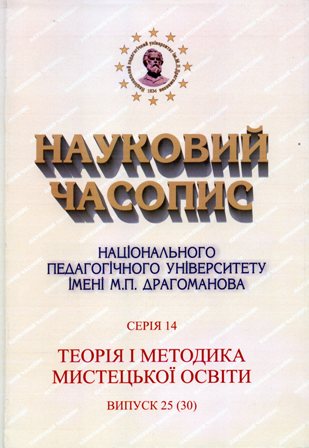Investigation of the activations ways of school-children artistic and creative activity in the conditions of choreography teacher creative studio
Keywords:
artistic and creative activity at school; choreography educator; creative personalityAbstract
The article is devoted to the problem of artistic and creative activity forming of schoolchildren in the choreographic collective. This problem is actual for the pedagogy of art, it is multifaceted and complex in view of what constitutes a symbiosis of properties characteristic of creativity, artistic creativity, and creative activity, as well as artistic and creative abilities of the individual. Today, a lot of modern scientific research and pedagogical experience of teachers convincingly proves that artistic creativity in school years is a condition and means of maximum disclosure of creative abilities, activation of emotionally-sensual and communicative sphere, cognitive interests and spiritual potential of schoolchildren. Unique opportunities for the development of schoolchildren by means of art include artistic and creative activity. It is in the process of this activity that the schoolchildren have the ability to see, to observe, to feel; freedom of playing fantasy, associations, ideas is acquired; the imaginative thinking is activated, a harmonious combination of intuition with logical mental operations is carried out. All of the above arsenal is aimed at creating something new by the schoolchildren themselves, which differs significantly from what they already know and, most importantly, is the result of their independent and fruitful work. In the context of our study, the artistic and creative activity of schoolchildren was carried out on the basis of Ukrainian folk rites and festivals, as folk wisdom and creativity fulfill the function of unity, interaction of upbringing and learning, stimulating the aesthetic self-improvement of schoolchildren and developing their creative talents. The article describes the stages, defined forms and methods of activating the artistic and creative activity of students in the choreographic team on the example of the Ukrainian national holiday "Andriivski Vechornytsi" ("St. Andrew Vespers"). Particular advantage in this event was given to group and dialogical forms. In our opinion, these forms contribute to the activation of the artistic and creative activity of schoolchildren, namely: the manifestation of activity and autonomy, the advent of creative ideas that differ in their non-standard and originality, emotional-shaped choreographic tasks, also collective analysis, exchange of views. In addition to the marked forms of activating the artistic and creative activity of schoolchildren in the choreographic team, we used the following methods: methods of providing aesthetic perception of artistic image (perception, demonstration, analysis, re-perception); methods of practical training (explanation, display, choreographic vocabulary); methods of artistic and creative action (justification of artistic design, performance of choreographic creative tasks, embodiment of artistic image, dialogue). Symbiosis of certain forms and methods is a way to enrich and accumulate personal artistic and creative experience of schoolchildren and a guarantee of their success in the choreographic team.
References
Volkova, N.P. (2006). Profesiino-pedahohichna komunikatsiia. [Professional-pedagogical communication]. Kyiv: VTs «Akademiia» [in Ukrainian]
Kolesnikov, M.P., Kolesnikova, O.V., Lozovoi, V.O., & etc. (Eds.). (2003). Estetyka [Aesthetics]. Kyiv: Yurinkom Inter. [in Ukrainian]
Moliako, V.O., Muzyky, O.L. (Eds). (2006). Zdibnosti, tvorchist, obdarovanist: teoriia, metodyka, rezultaty doslidzhen. [Abilities, creativity, giftedness: theory, methodology, research results]. Zhytomyr: Ruta. [in Ukr.]
Martynenko, O.V. (2016). Teoriia i metodyka roboty z khoreohrafichnym kolektyvom [Theory and method of work with the choreographic team]. Berdiansk. [in Ukrainian]
Mishchykha, L.P. (2007). Psykholohiia tvorchosti [Psychology of creativity]. Ivano-Fra¬nkivsk. [in Ukr.]
Kulchytska, O.I., Sysoieva, S.O., & Tsekhmister, Ya.V. (eds.). (2002). Pedahohichni tekhnolohii : nauka – praktytsi. Iss. 1. Kyiv: VIPOL [in Ukrainian]
Petrovskiy, A.V., & Yaroshevskiy, M.G. (Eds). (1990). Psykholohyia. Slovar [Psychology Dictionary]. Moscow: Politizdat [in Russian]
Romenets, V.A. (1965). Psykholohiia tvorchosti [Psychology of creativity]. Kyiv. [in Ukrainian]
Rudnytska, O.P. (2005). Pedahohika: zahalna ta mystetska [Pedagogy: general and artistic]. Ternopil: Navchalna knyha – Bohdan. [in Ukrainian]
Spyrkyn, A.H. (2001). Filosofiya [Philosophy]. Moscow : Hardaryky [in Russian]
Hubskyi, Y.F., Korableva, H.V., & Lutchenko, V.A. (Eds). (2002). Filosofskiy entsiklopedicheskiy slovar [Philosophical Encyclopedic Dictionary]. Moscow. [in Russian]
Shevchuk, A.S. (2016). Dytiacha khoreohrafiia [Children's choreography]. Ternopil : Mandrivets. 2016. 288 p. [in Ukrainian]
Yalanska, S.P. (2014). Psykholohiia tvorchosti [Psychology of creativity]. Poltava: PNPU imeni V.H. Korolenka. [in Ukrainian]

